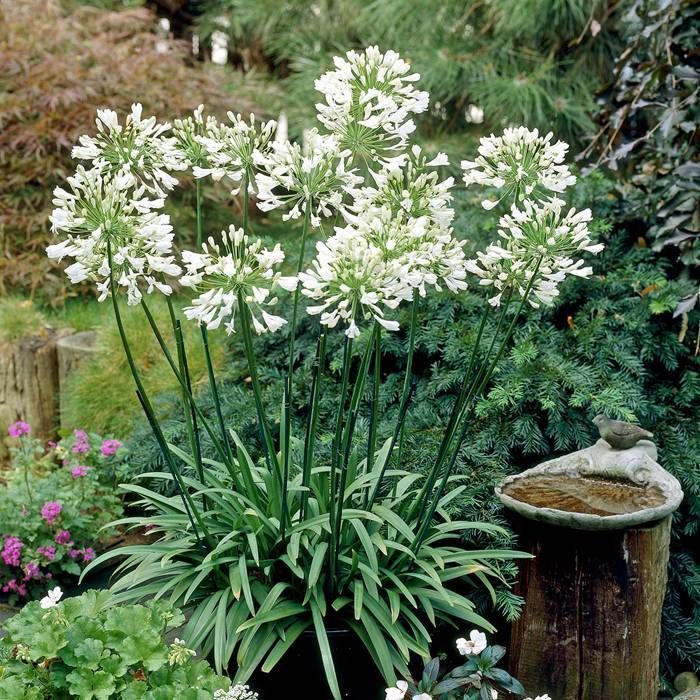Usual Agapanthus Problems and Exactly How to Solve Them
Usual Agapanthus Problems and Exactly How to Solve Them
Blog Article
Grasping the Art of Agapanthus Care: Crucial Actions for Healthy Growth and Lively Blooms
In the realm of cultivation, the cultivation of agapanthus stands as a fulfilling venture for those that seek to nurture these elegant blooming plants. With their striking blooms and graceful vegetation, agapanthus has actually caught the interest of gardeners worldwide. However, achieving optimum growth and lively blooms requires a nuanced method that includes numerous important actions. From choosing the right range to grasping pruning methods, the journey in the direction of cultivating flourishing agapanthus plants is diverse and holds the vital to opening the full possibility of these agricultural gems.

Picking the Right Agapanthus Selection

When choosing the best Agapanthus variety for your garden, think about aspects such as environment suitability, blossom shade, and development habit. Agapanthus, typically referred to as Lily of the Nile or African lily, comes in a range of shades varying from shades of blue and purple to white. Pick a flower shade that complements your existing yard palette to create an unified landscape. Furthermore, take into consideration the climate in your region to ensure the Agapanthus selection you select can flourish in your details problems. Some ranges are a lot more forgiving of cool temperature levels, while others favor warmer climates. Comprehending the development routine of various Agapanthus ranges is critical for correct placement within your garden. Some ranges have a clumping growth routine, ideal for containers or boundaries, while others have an even more spreading nature, appropriate for ground cover or mass growings. By thoroughly assessing these aspects, you can select the excellent Agapanthus selection to enhance the elegance of your yard.
Suitable Planting Problems
Taking into consideration the optimal environmental needs is important for effective Agapanthus growing. Agapanthus plants are delicate to chilly temperatures and must be protected from frost during winter months.
To ensure healthy growth and vivid blooms, plant Agapanthus light bulbs at a deepness of regarding 2-4 inches and space them 8-12 inches apart. Mulching around the base of the plants helps keep moisture and reduces weed growth.
Watering and Fertilizing Tips
Keeping correct moisture levels and giving important nutrients are crucial elements in the treatment routine for Agapanthus plants. It is important to strike a balance when it comes to watering Agapanthus. If overwatered, these plants favor regularly moist dirt but are prone to root rot. Throughout the expanding period, water deeply as soon as a week, making certain the soil is well-draining to avoid waterlogging. In hotter environments or during durations of dry spell, even more regular watering may be needed to maintain the soil evenly wet. However, lower watering in the winter season to stop additional reading waterlogged problems.
Fertilizing Agapanthus is vital for promoting healthy and balanced development and respected blossoms. Use a well balanced plant food, such as a 10-10-10 formula, in the very early spring as brand-new development arises. Repeat this application every 6-8 weeks throughout the growing season. Prevent too much fertilization, as it can bring about lavish vegetation at the cost of blooms. Constantly comply with the supplier's guidelines for proper dilution and application methods. By adhering to these watering and fertilizing suggestions, you can ensure your Agapanthus plants prosper and generate dynamic, durable flowers.
Pruning Methods for Agapanthus
Pruning Agapanthus plants at the proper times and with correct strategies is crucial for maintaining their wellness and advertising optimum development and blooming. The suitable time to prune Agapanthus is in late winter season or early springtime before new development arises.
Deadheading spent blossoms can also redirect the plant's power into generating even more blooms instead than establishing seeds. If you desire to gather seeds for breeding, leave some flowers to fully grown and dry on the plant.
Keep in mind to use clean, sharp tools to make accurate cuts and reduce the danger of presenting illness. Agapanthus. Normal pruning will aid maintain your Agapanthus looking healthy and balanced and neat while guaranteeing an abundant screen of Recommended Site attractive blossoms
Handling Usual Parasites and Diseases
After making sure proper pruning techniques for Agapanthus, it is necessary to resolve common insects and illness that can impact the health and wellness and vigor of these plants. One typical pest that influences Agapanthus is the Agapanthus gall midget.
One more common issue is fungal fallen leave spot, which provides as dark lesions on the fallen leaves. To stop fungal illness, make sure great air flow around the plants, prevent above watering, and get rid of any infected fallen leaves without delay. Additionally, Agapanthus plants can experience origin rot if they are grown in improperly draining pipes soil. To avoid this, plant Agapanthus in well-draining soil and prevent overwatering. By being watchful and taking prompt action versus parasites and illness, you can aid your Agapanthus plants prosper and create vibrant flowers.

Final Thought
To conclude, mastering the art of agapanthus care entails picking the ideal range, providing optimal growing problems, correct watering and feeding, suitable trimming Source techniques, and dealing with typical insects and illness. By adhering to these necessary actions, you can make sure healthy development and vibrant flowers for your agapanthus plants. Bear in mind to routinely check and maintain your plants to promote their total wellness and long life.
To guarantee healthy and balanced growth and lively flowers, plant Agapanthus bulbs at a deepness of about 2-4 inches and space them 8-12 inches apart. By complying with these watering and feeding suggestions, you can ensure your Agapanthus plants thrive and produce vivid, durable flowers.
One typical pest that affects Agapanthus is the Agapanthus gall midget. Additionally, Agapanthus plants can experience from root rot if they are planted in badly draining soil. By following these essential steps, you can guarantee healthy and balanced development and vibrant blooms for your agapanthus plants.
Report this page